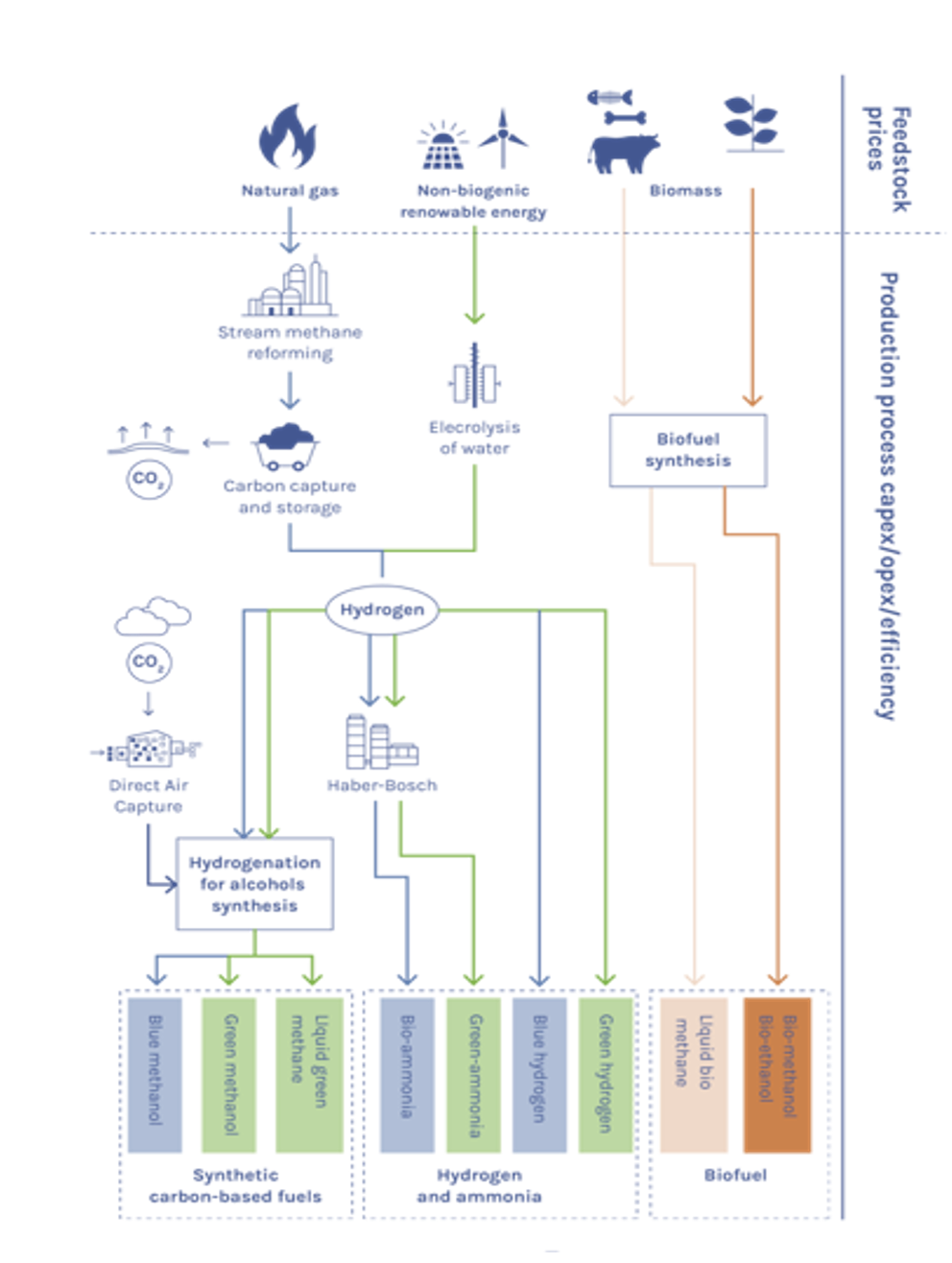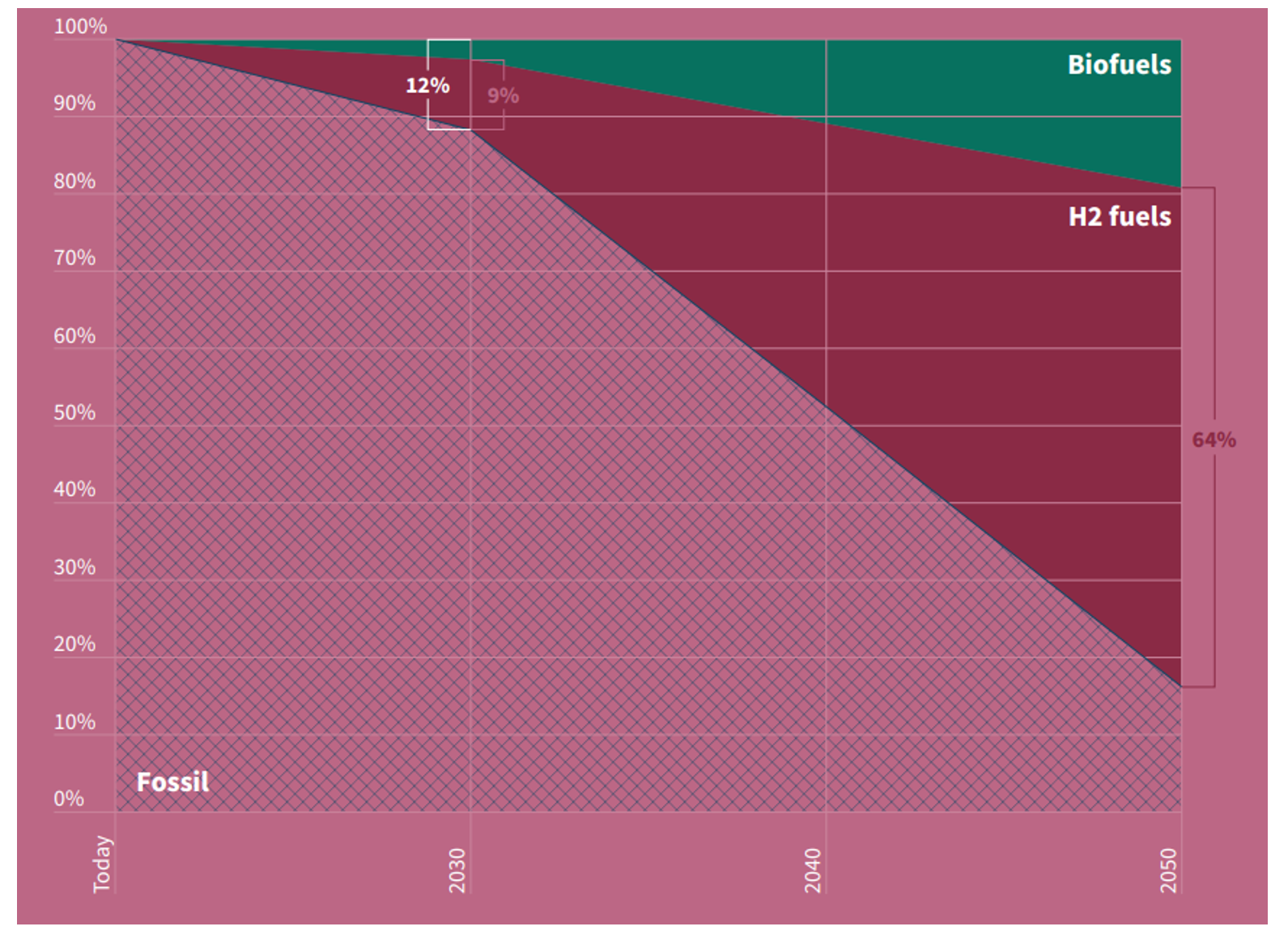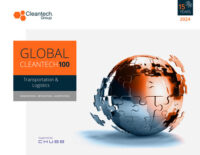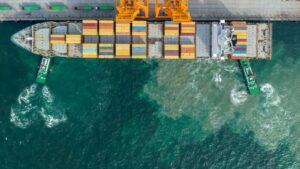The Green Hydrogen Conundrum – Maritime Decarbonization Edition
Hard-to-abate sectors (heavy industry, steel, aviation) are increasingly turning to hydrogen to realize decarbonization goals, and maritime shipping is not an exception. While interim decarbonization options such as liquefied natural gas (LNG) and fuel blending are currently available, widespread adoption of zero-carbon fuels is the only path to reach the International Maritime Organization (IMO)´s newest decarbonization targets for 2040 and 2050.
Alternative Fuels are Essential for Maritime Decarbonization
Currently, fuels make up between 30%-50% of vessel operating costs, and conventional fuels account for up to 99% of vessel energy demand. There are several synthetic zero-carbon alternatives to conventional bunker fuel, namely ammonia and methanol. The production of these fuels remains a nascent, though rapidly growing sector.
Incumbents and innovators are collaborating to address the production and storage/transport challenges that both ammonia and methanol present — such as cryogenic and high-pressure storage systems, high-energy production, engine innovation, and safety concerns (see A Perfect Storm for Maritime Sustainability). Perhaps the most significant hurdle to the global scaling of these alternative fuels is cost.
Green ammonia and e-methanol production is estimated at between 3 and 6 times more expensive than conventional bunker fuel, not taking into account additional transport and storage costs or vessel retrofits that may be required. Closing the cost gap between alternative fuels and conventional fossil fuels is a crucial step in order to provide an economically feasible alternative fuel option to enable decarbonization.
Lowering Alternative Fuel Costs
The key to bringing down the cost of future maritime fuels is green hydrogen, a key component in the production of both ammonia and methanol. To produce zero-carbon versions of these fuels (green ammonia and e-methanol), the hydrogen used for fuel production must be zero-carbon as well. Although the future fuel mix scenarios are uncertain, it is clear that abundant, low-cost green hydrogen will be essential to meet the demand for zero-carbon fuels as well as to reduce production costs sufficiently to allow for widespread market uptake.
Alternative Fuels Production Pathways

Average Trends for H2-fuels Scenarios

Innovation: SunGreenH2
Innovators and maritime incumbents alike are collaborating to increase production and reduce the cost of zero-carbon alternative fuels. SunGreenH2 is an interesting innovator that just appeared on the Cleantech Group 2024 APAC Cleantech 25 list. The developer of an electrolyzer leveraging nanostructured materials is based in Singapore. SunGreenH2´s electrolyzer system uses less energy than a conventional electrolyzer while producing up to twice the green hydrogen output—and without the need for precious metals.
The company’s goal is to harness increasingly abundant and cheap renewable energy and provide affordable green hydrogen to drive the energy transition. The proprietary platform technology and electrodes can also be applied to other decarbonization technologies, including fuel cells, batteries, energy storage, and solar-hydrogen panels. The first commercial test of SunGreenH2´s electrolyzer technology is currently underway in conjunction with Naturgy Innovahub in Spain.
Maritime Applications
CEO & Co-Founder Tulika Raj notes that it is essential to provide a cost-effective way to harness emissions abatement in order to meet maritime decarbonization targets. SunGreenH2´s modular, high-production system addresses this challenge, reducing the cost of implementing on-site green hydrogen production both for alternative fuel production and port operations.
The modular system requires about half the space of conventional electrolyzer systems, facilitating integration with on-site renewables and energy storage. Modular, high-capacity hydrogen production enables refuelling of hydrogen and hydrogen-electric machinery, and can complement battery electrification, reducing strain on the grid, and enabling the electrification of heavy-duty equipment such as cranes and forklifts.
Looking forward
Keep an eye out for…
- Zero-carbon fuels production innovations such as ammonia cracking
- Hydrogen and alternative fuels transport and storage innovation to reduce cost and space and address safety concerns, which will be key for market uptake
- Port decarbonization initiatives incorporating energy storage, electric vehicles, and refuelling and charging stations
- Dual-fuel engines compatible with both conventional bunker fuel and alternative fuels that will allow shipping companies to future-proof fleets despite uncertain fuel scenario futures



